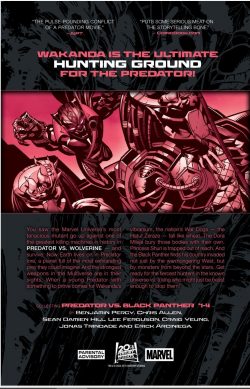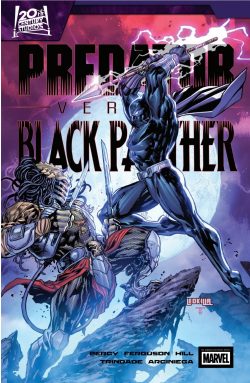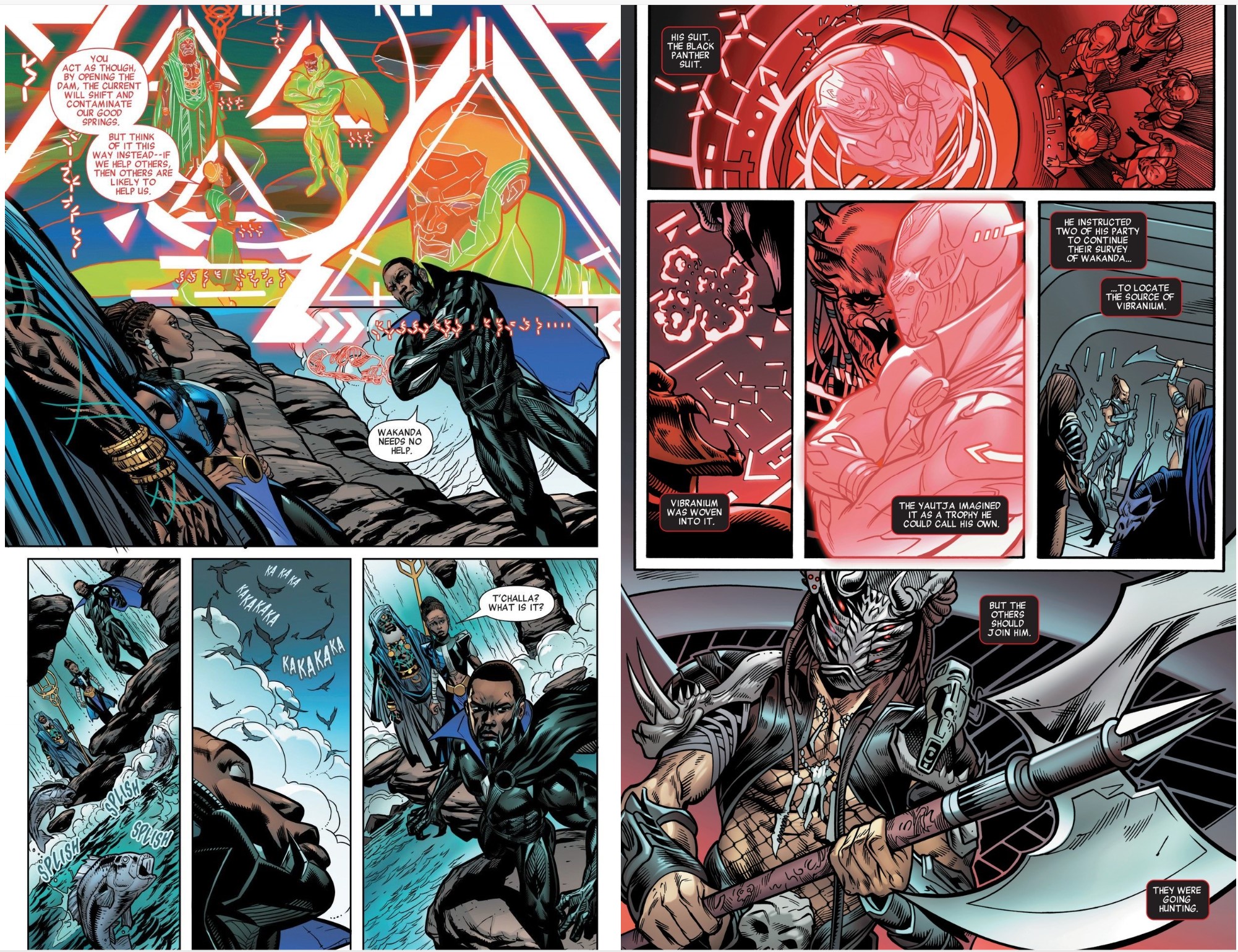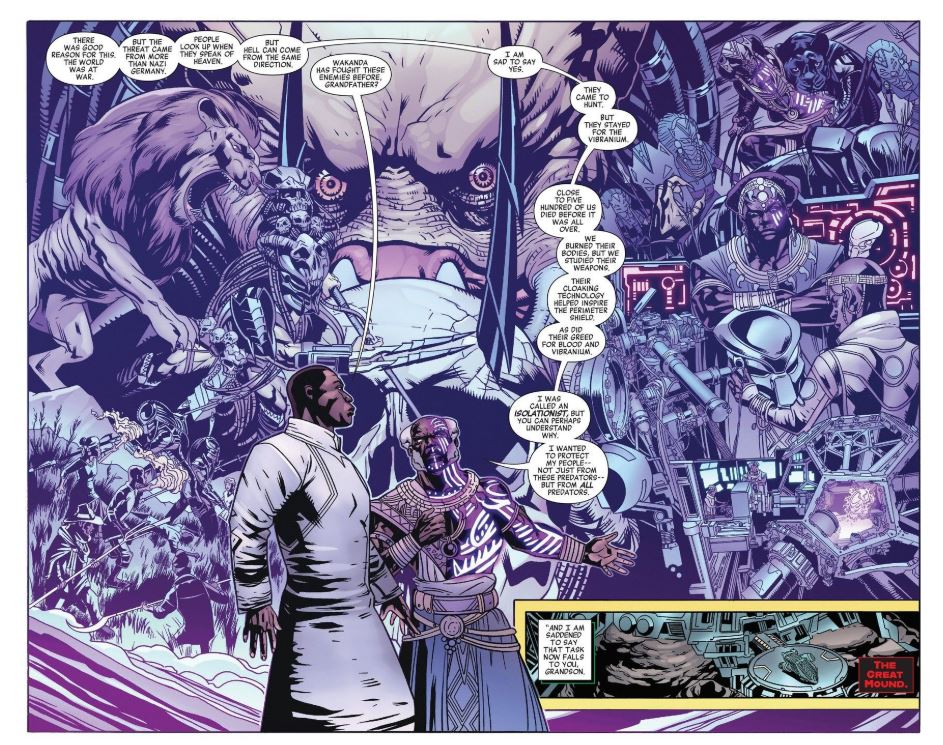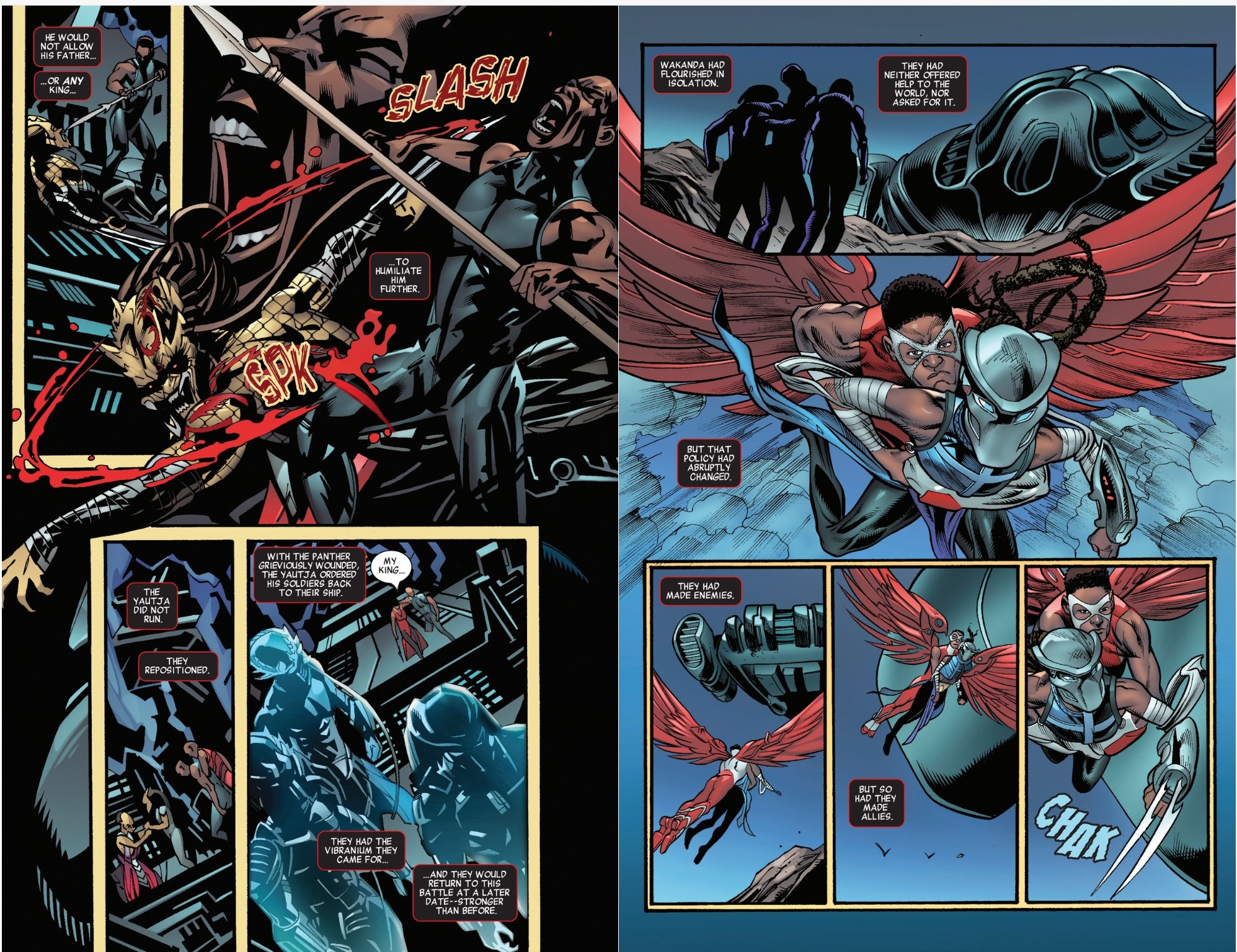

By Marv Wolfman, Jim Shooter, Roger McKenzie, Tony Isabella, Bill Mantlo, Chris Claremont, Gerry Conway, Gil Kane, Don McGregor, Bob Brown, Carmine Infantino, John Buscema, Frank Robbins, John Byrne, Sal Buscema, George Tuska, Lee Elias, Gene Colan, Tom Sutton, Jim Mooney, Klaus Janson, Vince Colletta, Don Perlin, Keith Pollard, Frank Chiaramonte, Al Milgrom, Dan Green, Tony DeZuñiga, Steve Leialoha, Josef Rubinstein, Bob Wiacek & various (MARVEL)
ISBN: 978-1-3029-1634-3 (HB/Digital edition)
This book includes Discriminatory Content produced in less enlightened times.
Matt Murdock is a blind lawyer whose remaining senses hyper-compensate, making him an astonishing acrobat, formidable fighter and living lie-detector. A second-string hero for much of his early career, Daredevil was nonetheless a striking and popular one, due mostly to the captivatingly humanistic art of Gene Colan. DD fought gangsters, super-villains and even the occasional monster or alien invasion, quipping and wisecracking his way through life and life-threatening combat, utterly unlike the grim, moody, quasi-religious metaphor he became.
After a disastrous on-again, off-again relationship with his secretary Karen Page, Murdock took up with Russian émigré Natasha Romanoff, infamous and notorious ex-spy Black Widow. She was framed for murder and prosecuted by Matt’s best friend and law partner Foggy Nelson before the blind lawman cleared her. Leaving New York with her for the West Coast, Matt joined a prestigious San Francisco law firm but adventure, disaster and intrigue sought out the Sightless Sentinel and ultimately drew him back to the festering Big Apple…
Spanning May 1976 to May 1977, this Epic Collection re-presents Daredevil #133-154, Annual #4, a crossover from Ghost Rider #19-20, plus spin-offs from Marvel Premiere #39-40 & 43, spanning cover-dates May 1976 and September 1978.
Writer/editor Marv Wolfman always designed long term plans for his characters which oddly start buried in the publicity stunt yarn opening this collection. Daredevil #133 begins laying groundwork for an unfolding epic about fake news and disinformation in public office (and remember this is set just after Watergate and decades before Trumpism) before digressing to a fanciful fluff piece co-starring real-world stage trickster and headline-seeker Uri Geller. Concocted by Wolfman, Bob Brown & Jim Mooney, ‘Introducing: Mind-Wave and his Fearsome Think Tank!’ is a happily forgettable tale about a maniac in a supertank attacking Manhattan. Thankfully, Mind-Wave‘s arch enemy (Geller, claiming to have psychic powers granted him by aliens) is there to aid the Scarlet Swashbuckler…
More sinister secrets of the perception-shaping masterplan of The Jester are revealed in #134’s ‘There’s Trouble In New York City…’ as disgruntled former football star/insurance salesman Brock Jones returns. Previously, he had stumbled into a plot to control Earth and taken possession of a rocket-powered super-suit coveted by enemy agents. DD had almost been killed by the suit’s original owner, leading to the usual superhero misunderstanding and a savage clash. Now, as TV news shows Daredevil killing cops and with the shapeshifting Chameleon robbing at will, Brock again dons the suit to help the common man as The Torpedo, innocently adding to the chaos and confusion before the Chameleon is caught…

Jester’s grand scheme is revealed in ‘What Is Happening?’ The Manic Mountebank has exploited a computer pioneer to create a wave of stories making the public mistrust the authorities by manipulating the media. (I’m not commenting, I’m not commenting…)
Seeing newspaper reports, photos and even news tapes of John and Robert Kennedy alive, superheroes killing cops and “proof” that the Viet Nam war never happened, but secret conflicts in Chile and Saudi Arabia did, much of the public readily accepts the villain was framed, resulting in Daredevil being arrested and subsequently handed over to an army of thugs and gangsters.
John Buscema assumed pencilling with #136, as the Jester’s endgame is exposed. When President Gerald Ford announces that New York City’ s police and all its superheroes have gone insane, citizens are urged to take up arms and defend themselves at all costs. The entire scheme has been devised to leave the city open to plunder by the Jester’s hastily-assembled army of thugs. Unable to keep away, DD strikes back but is captured and subjected to ‘A Hanging for a Hero!’
As a lynch mob of panicked citizens and enraged criminals almost execute the Man Without Fear, he flamboyantly escapes but is forced back into action for concluding episode ‘The Murder Maze Strikes Twice!’ as “President Ford’s” broadcasts demand citizens “take back Wall Street” from the gangsters that now control it. Deducing Jester’s location, DD storms in, dismantles all the villain’s traps and minions, restoring order and justice, only to discover personal crises boiling over…
Throughout the media reality war, Daredevil had been seeking to prove the innocence of Heather Glenn‘s father. Matt Murdock’s current girlfriend knows her dad isn’t a ruthless, murdering slumlord but that someone must have framed him. All evidence says otherwise. Now, as Matt and Foggy return to that case, word comes (for readers, as two excerpted pages from Ghost Rider #19 – August 1976 by Tony Isabella, Frank Robbins & Vince Colletta) depicting former girlfriend turned soap star Karen Page being kidnapped by friend and ally Stuntman…
It leads directly into Daredevil #138 where Wolfman, John Byrne & Mooney ask ‘Where is Karen Page?’ as the Man Without Fear drops everything for his one true love: heading for Los Angeles where Page is a Hollywood star with a complex convoluted life. However her relationship with hell-tainted Johnny Blaze is not why she was targeted, but rather from her father’s inventions and career as super-maniac Death’s Head – and the impostor now using the name to further his own insane plans. The saga concludes in Ghost Rider #20 (Wolfman, Byrne & Don Perlin) as ‘Two Against Death!’ reveals who is actually pulling all the strings with Satan-spawn and Scarlet Swashbuckler pairing to save page. Meanwhile in Manhattan, Foggy continues investigating Glenn Industries… and is shot.
The plot threads expands in Daredevil Annual #4’s ‘The Name of the Game is Death!’ Plotted by Wolfman, scripted by Chris Claremont, drawn by George Tuska and inked by Frank Chiaramonte, it sees The Black Panther aiding an industrialist whose son is abducted. Thanks to friendship with King T’Challa and judicious use of Vibranium, Robert Mallory has built the world’s first Tidal Power Station. Someone thinks holding his son will win them the plans but hasn’t counted on T’Challa paying his friend a visit at this inopportune moment…
Daredevil, meanwhile, fights for his life, having stumbled into a furiously rampaging Sub-Mariner. Prince Namor has returned to the vile surface world because of a man named Mallory and a power station that while providing cheap clean energy for mankind will overheat the seas and divert the tides…
Concluding chapter ‘And Who Shall Save the Panther?’ begins with the Great Cat prowling Manhattan, having tracked the crime to ambitious mobster Ruffio Costa. Sadly, he’s unable to defeat the thugs alone and eventually DD steps in to deliver a ransom, accidentally bringing Sub-Mariner along for the ride. When the superbeings converge and clash, Costa is caught in the carnage and a lab explosion transforms him into something far worse than gradual climate crisis and the factions must all temporarily unite to defeat the threat of Mind-Master.
The editorial story behind Wolfman, Sal Buscema & Mooney’s ‘A Night in the Life’ (DD #139) is a true insight to comics at their best, but for readers it’s simply a chance to enjoy enhanced drama, suspense and action as the search for a missing haemophiliac boy overlaps a police manhunt for a mad bomber demanding the return of his drug-addicted wife. Wolfman was unsurpassed at interleaving soap opera melodrama with costumed cavorting, and the fraught tone carried over into #140 as Bill Mantlo, Sal B & Klaus Janson detailed ‘Death Times Two!’ when a runaway bus dumped Daredevil into a hunt for accidentally united old enemies The Gladiator and The Beetle who then aimed a runaway train at Grand Central Station and attempted to settle old scores with the hero amidst the dead and dying…
An even bigger change in tone began in #141. ‘Target: Death!’ was plotted by Wolfman, and scripted by Jim Shooter, with pencils divided between Gil Kane and Bob Brown, and Jim Mooney inking. It is very much a forerunner of what Roger McKenzie and Frank Miller would conceive of in months to come, opening with another murder attempt on Foggy and fresh insights into the abduction of his fiancée Debbie Harris. More secrets of Glenn Industries are teased out, a killer dies and DD’s ultimate arch-nemesis returns for another killing spree before abruptly changing his mind and tying defeated Daredevil to a giant arrow and firing him at the New Jersey Palisades…
Pulling out all the stops for his final forays, Wolfman – with Brown & Mooney – resurrected more classic villains for #142. Escaping one doom, DD meets new hero Nova, even as Mr. Hyde and The Cobra reunite, targeting the Scarlet Swashbuckler as he passes the rooftop rainforest garden of a young millionaire living in a personal paradise: ‘The Concrete Jungle’
The clash concludes with ‘“Hyde and Go Seek”. Sayeth the Cobra!’ (Wolfman, Brown & Keith Pollard) wherein the villains leave our hero to the carnivores populating the skyscraper Eden while they plunder the penthouse below. The goal is not wealth but ancient books and formulas to enhances their powers, but as ever, they grievously underestimate the boldness and ingenuity of the Man Without Fear…
Times were changing for the Scarlet Swashbuckler, and stories by incoming scripters including Jim Shooter and Roger McKenzie contributed to a gradual darkening of the atmosphere. In DD #144 Shooter, penciller Lee Elias & inker Dan Green amp up the edginess and intensify foreboding shadows by proving ‘Man-Bull Means Mayhem’ as the petty thug-turned-mutated-menace Bill Taurens again clashes with the Crimson Crusader. The battle begins when he breaks jail to join DD’s oldest archenemy The Owl and it emerges the avian ganglord is critically enfeebled, under attack by rivals and needs the Man-Bull to kidnap the one scientist who can fix him. Sadly, the boffin might also be able to cure Taurens, and the brute’s selfish betrayal leads to disaster when Daredevil intervenes again…
The Owl’s fate is sealed in ‘Danger Rides the Bitter Wind!’ (by Shooter from a Gerry Conway plot, illustrated by George Tuska & Jim Mooney) as the desperate human raptor goes after Dr. Petrovic personally, raiding a hospital and triggering his own doom in a rooftop clash with Daredevil. Shooter then amps up tension as #146 welcomes Gil Kane as penciller for Mooney and maniac marksman Bullseye returning to force a showdown ‘Duel!’ with the hero, achieved by taking an entire TV studio hostage before being soundly defeated yet again…

Throughout The Jester’s media reality war, DD had dated flighty socialite Heather Glenn. When, as both masked hero and lawyer he discovered her father was a corrupt slumlord and white collar criminal, the hero began looking for proof to exonerate his potential father-in-law. Instead he found further damning proof everywhere he looked. Matt’s girlfriend knows her dad isn’t a ruthless, murdering monster and that someone must have framed him. All evidence says otherwise…
Now another long running plot thread – with Foggy’s kidnapped girlfriend now held for months – converges as DD confronts Maxwell Glenn and the true culprit reveals himself to readers if not the hero. As Glenn confesses to everything and is arrested, the hero hits his ‘Breaking Point!’ (Shooter, Kane & Janson) after dramatically liberating the broken captive but failing to catch the true villain – mindbending archfoe Killgrave, the Purple Man…
With Kane co-plotting, and Glenn believing himself guilty, #148’s ‘Manhunt!’ sees the increasingly overwhelmed adventurer lash out at the entire underworld in search of the malign mauve manipulator, only to stumble into a wholly separate evil plot instigated by the another enemy – the diabolical Death-Stalker. Murdock’s relationship with Foggy also takes a hit as the usually genial partner deals with a PTSD ravaged Debbie and can’t understand why his best friend is defending self-confessed perpetrator Glenn…
Carmine Infantino joins Shooter & Janson for DD #149 as ‘Catspaw!’ sees Heather dump Matt and super-thug The Smasher target Daredevil in a blistering battle bout that is mere prelude to #150’s ‘Catastrophe!’, finding the valiant crusader stretched beyond his capacity in the courtroom and on the streets, just as charming, debonair mercenary Paladin premieres in a clash of vigilante jurisdictions. The debuting mercenary hero for hire is also hunting the Purple Man and has advantages DD can’t match, and no scruples at all…
Kane returns as plotter and penciller as Shooter gives way to McKenzie, who joins the creative crew to script ‘Crisis!’ with another tragic death blighting Murdock’s soul. As a result, Heather accidentally uncovers Matt’s heroic secret and DD simply quits. However, the horrors of the world and his own overzealous Catholic conscience soon force him back to work again…
Paladin and Infantino return for ‘Prisoner!’ (DD #152) joining McKenzie & Janson in reintroducing Death-Stalker just as our masked hero makes an intervention to reunite Foggy with traumatised fiancé Debbie. Although the ploy is successful, another clash with the mercenary leaves DD beaten and open to a surprise attack by The Cobra & Mr Hyde in #153. Crafted by McKenzie, Gene Colan & Tony DeZuñiga, ‘Betrayal!’ debuts aging Daily Bugle reporter Ben Urich – who will play a huge part in Daredevil’s future – with the weary hero ambushed, defeated and dragged to the ‘Arena!’ (Steve Leialoha inks) wherein Killgrave seeks ultimate victory by mind-piloting a squad of DD’s foes, including The Gladiator, Jester, Cobra & Hyde, to slaughter the swashbuckler in front of a captive audience. It proves to be the fiend’s final mistake once Paladin shows up and shifts the balance of power…

To Be Continued…
At this period the series was generating plenty of noteworthy characters, and included here are some solo spin-off stories that resulted. First is a two-issue try-out tale starring hero/ villain The Torpedo. He first (accidentally) battled DD in Daredevil #126-127. After the brief reprise recounted above he was given his shot at fame in Marvel Premiere #39 & 40 (December 1977 – January 1978) before ultimately dying in Rom: Spaceknight and being replaced by a teenaged girl.
‘Ride a Wild Rocket!’ and ‘…Battle With the Big Man!’ was a rushed-looking collaboration of Wolfman, Mantlo, Brown, Al Milgrom, Josef Rubinstein, Bob Wiacek & Alan Weiss showing Brock Jones pursuing the Rocketeer gang who originally owned his turbo-suit, but all his efforts to reclaim the acclaim of his quarterbacking days seem pointless. Harassed at home and bored at work, his American Dream is dying. After almost triggering a nuclear meltdown he was considered a menace, even though he saved the state from atomic catastrophe, and now a critical change comes after the hidden mastermind behind all his woes and superhero aspirations decides enough is enough…
As seen in Captain America, Machine Man, and The Incredible Hulk, long-time villain Senator Eugene “Kligger” Stivak is a high-ranking official of criminal capitalists The Corporation who decides he will deal with Brock personally, but the villain has seriously underestimated the over-the-hill hero’s stubbornness and desperation to regain his self-esteem…
Also included here is a Paladin pilot from Marvel Premiere #43; cover-dated August 1978 and devised by Don McGregor & Tom Sutton as a super hero/bodyguard/private eye mash-up, with Paladin Paul Denning learning ‘In Manhattan, They Play for Keeps’. Here the suave merc faces a new iteration of Mr Fear calling himself Phantasm. Mutated in a radiation accident, the maniac soon graduates from abusive boyfriend to enemy of capitalism, fixated on old girlfriend Marsha Connors until she hires Paladin to save her…
Supplementing the resurgent rise in comics form is a cover gallery by Ed Hannigan, Rich Buckler, John Buscema, Al Milgrom, Dave Cockrum, Kane, Tom Palmer, Joe Sinnott, Ron Wilson, Frank Giacoia, Janson, Terry Austin, Colan, Steve Leialoha, Infantino & Frank Springer. The extras sections include Wolfman’s editorial from #133 detailing circumstances of Geller/Marvel’s publicity stunt, pages The Mighty Marvel Bicentennial Calendar 1976 from Marvel Comics Memory Album 1977 (by Sal Buscema and Gil Kane), house ads and original art pages by John Buscema, Mooney, Byrne, Brown, Kane & Janson.
As the 1970s closed, these gritty tales laid the foundation for groundbreaking mature dramas to come, promising the true potential of Daredevil was finally in reach. Their narrative energy and exuberant excitement are dashing delights no action fan will care to miss.
… And the next volume heads full on into darker shadows, the grimmest of territory and the breaking of many boundaries…
© 2024 MARVEL.
